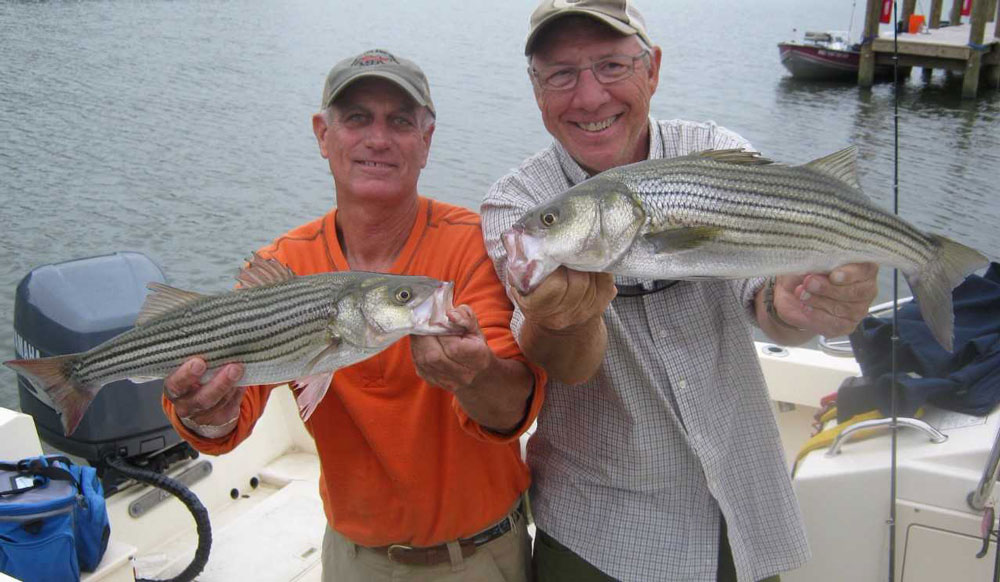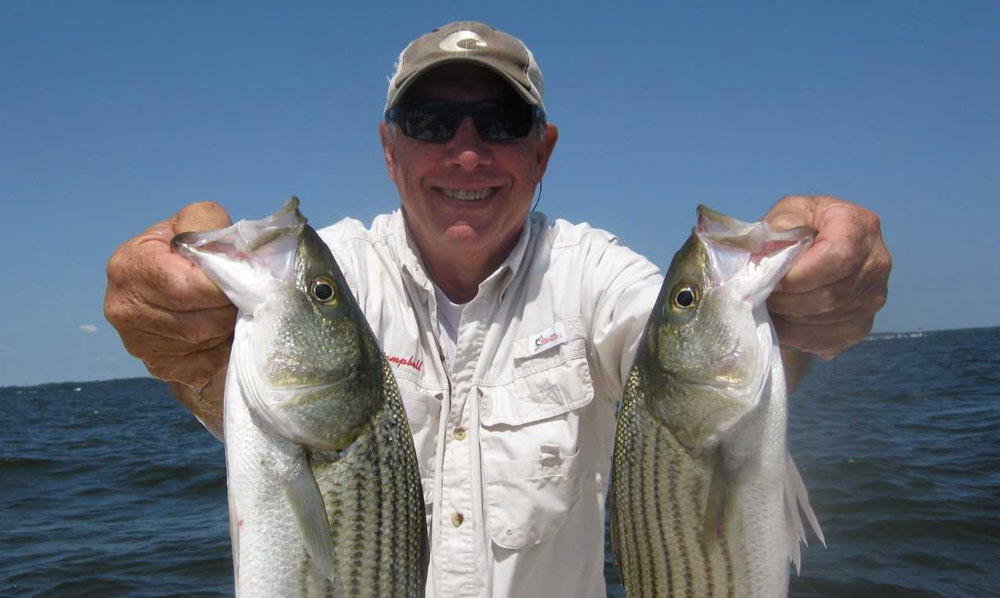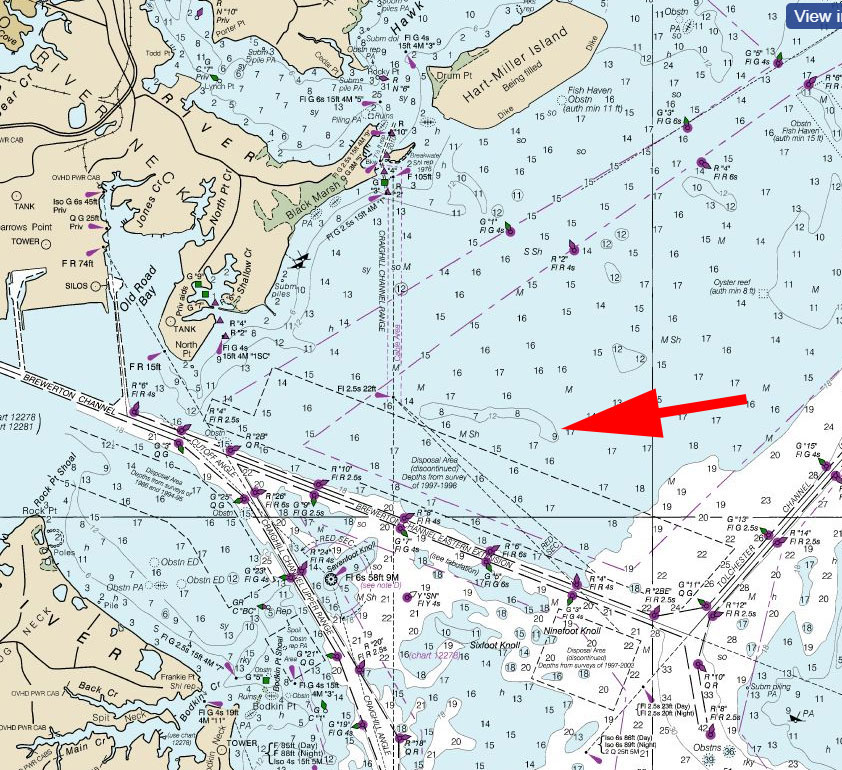Located in the Upper Bay just south of Hart-Miller Island at N39° 11.146 X W76° 22.020, Man O’ War shoal is within easy reach of Baltimore anglers. The main reason fishing around Man ‘O War is so productive is because the shoal is made up of between 83 and 103 million bushels of fossil oyster shell. The benthic species living on or near the 456 acre reef attracts all kinds of fish. In fact, this season one lucky angler caught a 52-inch black drum there while trolling in early October. It’s not unheard of to catch black drum this far up the bay, but getting one here – especially that late in the year – is certainly a surprise.

Basic Training
On any given weekend you might see 20 or more boats fishing around the shoal, but don’t be deterred. The fish move around, it’s a big area, and there’s room for all. Some anglers may be trolling, others may be anchored soaking bait, and jiggers will often be drifting across the shoal while looking for birds. If you don’t see birds then use your sonar to find the fish, slowly zig-zagging along the edges of the shoal while looking for marks on the screen. Once you see good marks, turn off the engine and start casting or jigging. Vary your retrieve until you find the way the fish want the lure. Sometimes the stripers bite on a very fast retrieve, and other times slow rolling swim baits is the way to go. Use half or three-quarter ounce jig heads.
Small striped bass, bluefish (during the warmer months) and white perch are the most common catches around the shoal, but don’t be surprised if you catch a channel catfish or two. There are lots of catfish in the Upper Bay and they will eat almost anything. To catch 50 or 60 striped bass while jigging artificial lures is typical, especially in late summer and fall. Granted, most of the stripers you find here will be under the 20-inch minimum size, but it’s not hard to get a few box-fish and once in a while a 30-incher.
Remember that when encountering a lot of throw-backs, it’s wise to use barbless hooks. It’s easier to unhook a squirming fish and it doesn’t harm them nearly as much. Be respectful of the resource and strive to conserve the next generation of striped bass; consider smashing down the barb on your jigs. Another reason to do so: if you’re fishing with young or inexperienced anglers remember that barbless hooks won’t cause much in the way of lost fish, but if somebody gets a hook stuck in them past the barb then the trip is over.

Pitched Battle
There is more to the story of Man ‘O War shoal than the fishing we can enjoy here. Maryland dredged over 185 million bushels of oyster shell in the Bay from 1960 until 2006 and moved it for replenishment projects. The repletion program helped to subsidized the oyster industry for the short-term, but it was just a temporary solution. Today Maryland still has a failing oyster industry and oysters are at about one to two percent of their historic population, thanks to disease, over-harvesting, and pollution. Man ‘O War shoal is one place in the Upper Bay where there is a concentration of shell left, and last spring Maryland’s Department of Natural Resources re-applied to the U.S. Army Corps of Engineers for permits to dredge Man O’ War shoal. Again. They had applied for a dredging permit in 2009, when the Corps recommended the agency find alternative substrate rather than dredging up Man ‘O War.

Maryland Saltwater Sportfishing Association’s executive director Dave Smith, in an interview for an article in FishTalk’s sister publication PropTalk Magazine, pointed out that from a fisherman’s perspective dredging the shoal is less than ideal. “The department for some reason can’t leave this location alone,” he said. “What they need to do is spend some time and money to identify alternate shell deposits in the Bay, if in fact they still think dredging up old shell will get us to where we need to be. The MSSA would suggest that alternate materials such as concrete or fossil shell from other coastal states would be more beneficial.”
David Sikorski, executive director of Coastal Conservation Association of Maryland, said in the same article that sport anglers already pay more than their fair share to DNR, and shouldn’t have to foot the bill for “destroying a favorite recreational fishing spot” such as Man O’ War Shoal.
“Maryland does not have any way of controlling the fresh oyster shell that is harvested each year right now, and we already failed at dredging and moving fossil shell around the Bay,” he said. “What makes anyone think that we will get it right this time around?”
Unfortunately, in June the Corps issues a letter to the DNR indicating their agreement with several recommendations of the National Marine Fisheries Service Habitat Conservation Division “should a Corps permit be issued,” so the prospect of dredging Man ‘O War certainly still exists. (This letter, along with the permit application and other pertinent documents, is published on the DNR’s web site Fisheries pages, under the “Permits” link).
Winning the War
Oyster shells from MOW shoal are not necessary for oyster restoration because oyster spat will set on a lot of materials other than oyster shell. Dredging the shoal for shell to subsidize the commercial oyster industry makes no sense. Without a moratorium on oysters, it will take decades to turn the Maryland oyster industry around.
Upper Bay anglers have enjoyed fishing around MOW shoal for many years and don’t want it ruined. Man O’ War shoal should remain undisturbed and hopefully, the permit will be denied. It’s time to put this issue to rest. Fishing at Man O’ War shoal should remain a bountiful upper bay fishing spot for now and for generations to come.
Sign up here to get the weekly FishTalk Chesapeake Bay and Mid-Atlantic fishing reports in your email inbox, every Friday by noon.